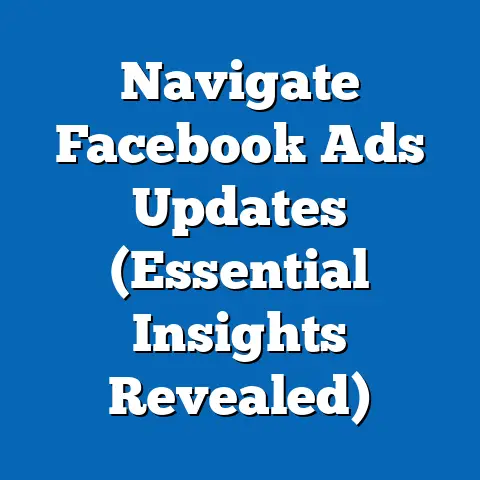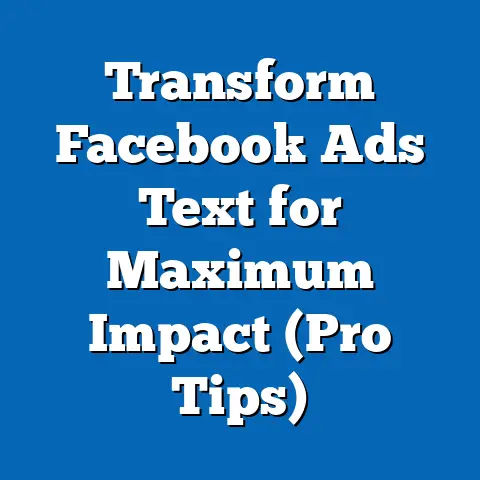Target Global Audiences with Facebook Ads (Expert Strategies)
I’ve been working with Facebook Ads for over a decade now, and one thing that’s always impressed me is the platform’s constant evolution. Facebook has really upped its game recently, introducing upgrades and enhancements to its advertising platform that make reaching global audiences easier and more effective than ever before. We’re talking improved audience targeting tools, advanced analytics that give you laser-like focus, and new ad formats that are more engaging and impactful.
These advancements are crucial because digital marketing is no longer just a local or national game; it’s global. And Facebook ads are a powerful tool to expand your business’s reach across borders. In this guide, I’ll walk you through the strategies I’ve learned over the years, showing you how to leverage Facebook’s capabilities to connect with audiences worldwide.
Understanding the Global Landscape
Before diving into the technical aspects, let’s define what it truly means to target a global audience with Facebook ads. It’s not just about showing your ads to people in different countries; it’s about understanding and respecting the nuances of each market.
What does it mean to target a global audience?
For me, it means tailoring your message to resonate with people from diverse cultural, economic, and linguistic backgrounds. Think of it as crafting a unique user experience for each segment of your global audience.
The global audience is incredibly diverse. Cultural differences, language barriers, and varying consumer behaviors all play a significant role in how your ads are received. What works in North America might completely flop in Asia or Europe.
Why is market research so important?
I can’t stress this enough: thorough market research is non-negotiable. You need to understand the specific needs, preferences, and sensitivities of each region you’re targeting. This involves:
- Analyzing cultural norms: What are the accepted social behaviors? What are the taboos?
- Understanding language nuances: It’s not enough to just translate your ads; you need to ensure the language is culturally appropriate and resonates with the local audience.
- Identifying consumer behaviors: How do people in this region shop? What are their purchasing habits? What are their pain points?
- Competitive analysis: Who are your competitors in this market? What are they doing well? What are their weaknesses?
Takeaway: Targeting a global audience is about more than just geographical reach; it’s about understanding and adapting to diverse cultural, linguistic, and behavioral nuances. Thorough market research is essential for success.
Setting Up Your Facebook Ads for Global Reach
Now that we’ve established the importance of understanding your target markets, let’s get into the practical steps of setting up your Facebook ads for global reach.
Choosing the Right Campaign Objective
The first step is to select a campaign objective that aligns with your global outreach goals. Facebook offers a variety of objectives, but some are better suited for global campaigns than others. Here are a few I recommend:
- Brand Awareness: This objective is ideal for introducing your brand to new markets and increasing its visibility. It focuses on reaching people who are likely to remember your ads.
- Reach: Similar to brand awareness, this objective aims to show your ads to the maximum number of people in your target audience.
- Traffic: If your goal is to drive traffic to your website or landing page, this objective is a good choice. It targets people who are likely to click on your ads.
- Lead Generation: This objective is perfect for collecting leads from potential customers in different regions. It allows you to create lead forms directly within Facebook.
- Conversions: If you’re looking to drive specific actions on your website, such as purchases or sign-ups, this objective is the way to go.
Audience Targeting Options
Facebook’s audience targeting options are incredibly powerful, allowing you to reach specific demographics, interests, and behaviors across the globe. Here’s a breakdown of the key targeting options:
- Custom Audiences: These are audiences you create based on your existing customer data, such as email lists or website visitors. You can upload your customer data to Facebook and match it with users on the platform. This is a great way to target people who are already familiar with your brand.
- Lookalike Audiences: These are audiences that Facebook creates based on your Custom Audiences. Facebook analyzes the characteristics of your existing customers and finds people who are similar to them. This is a fantastic way to expand your reach and find new customers in different regions.
- Demographic Filters: These filters allow you to target people based on their age, gender, location, education, and other demographic factors. This is useful for narrowing down your audience and ensuring your ads are shown to the right people.
- Interest Targeting: This allows you to target people based on their interests, hobbies, and activities. This is a great way to reach people who are passionate about your product or service.
- Behavior Targeting: This allows you to target people based on their online behavior, such as their purchase history or the types of websites they visit. This is useful for reaching people who are likely to be interested in your product or service.
Language and Localization
Language and localization are critical for global campaigns. You need to ensure your ads are translated accurately and culturally relevant. Here’s what I’ve learned:
- Language Settings: Facebook allows you to target people based on the languages they speak. Make sure you select the appropriate languages for each region you’re targeting.
- Translation: Don’t rely on generic translation tools. Hire professional translators who understand the nuances of the local language and culture.
- Cultural Adaptation: It’s not enough to just translate your ads; you need to adapt them to the local culture. This might involve changing the visuals, the messaging, or even the product itself.
Example: I once ran a campaign for a clothing brand targeting both the US and France. We used the same product images, but the ad copy was completely different. In the US, we focused on the comfort and durability of the clothing. In France, we emphasized the style and elegance. The result? Higher engagement and conversion rates in both markets.
Takeaway: Setting up your Facebook ads for global reach requires careful consideration of campaign objectives, audience targeting, and language and localization. Don’t underestimate the importance of tailoring your ads to the specific needs and preferences of each region you’re targeting.
Crafting Compelling Ad Creatives
Your ad creatives are the first thing people see, so they need to be visually appealing and culturally relevant. A generic ad that works in one country may not resonate with audiences in another.
The Importance of Visual Appeal and Cultural Relevance
Think about it: your ad is competing for attention in a crowded newsfeed. To stand out, it needs to grab people’s attention and make them want to learn more. This requires:
- High-Quality Visuals: Use professional-quality images and videos that are relevant to your target audience.
- Culturally Appropriate Imagery: Avoid using images that might be offensive or insensitive in certain cultures. For example, certain colors or symbols might have different meanings in different parts of the world.
- Compelling Messaging: Your ad copy should be clear, concise, and persuasive. It should also be translated accurately and culturally relevant.
Best Practices for Designing Ad Content
Here are some best practices I’ve found helpful for designing ad content that appeals to a global audience:
- Use Appropriate Visuals and Messages: Choose visuals and messages that resonate with the local culture. This might involve using different models, different settings, or different color schemes.
- Incorporate Local Influencers or Testimonials: Partnering with local influencers or featuring testimonials from local customers can add credibility to your ads and make them more relatable.
- Ensure Accurate and Culturally Relevant Translation: As I mentioned earlier, don’t rely on generic translation tools. Hire professional translators who understand the nuances of the local language and culture.
Examples of Successful Global Facebook Ads
Let’s look at a few examples of Facebook ads that have effectively targeted global audiences:
- Airbnb: Airbnb often features images of unique homes in different parts of the world. This allows them to showcase the diversity of their offerings and appeal to a wide range of travelers. They also use localized ad copy that highlights the unique features of each destination.
- Nike: Nike is known for its powerful and inspiring ad campaigns. They often feature athletes from different countries, which helps them connect with audiences around the world. They also use localized messaging that speaks to the specific needs and aspirations of each market.
Takeaway: Crafting compelling ad creatives is essential for global campaigns. Focus on creating visually appealing and culturally relevant ads that resonate with your target audience. Don’t be afraid to experiment with different visuals, messages, and formats to see what works best.
Utilizing Advanced Targeting Features
Facebook offers a range of advanced targeting features that can help you refine your global audience targeting. Let’s explore some of the most effective options:
Interest Targeting
Interest targeting allows you to reach people who are interested in specific topics, hobbies, or activities. This can be a powerful way to connect with potential customers who are passionate about your product or service.
- How to Find Specific Interests: Start by brainstorming a list of interests that are relevant to your product or service. Then, use Facebook’s Audience Insights tool to research those interests and identify related interests that you might not have considered.
- Leveraging Global Interests: Consider using interests that are popular across multiple countries. For example, if you’re selling fitness equipment, you might target people who are interested in yoga, running, or weightlifting.
Behavior Targeting
Behavior targeting allows you to target people based on their online behavior, such as their purchase history or the types of websites they visit. This can be useful for reaching people who are likely to be interested in your product or service.
- Targeting Based on User Behaviors: Use behavior targeting to reach people who have recently made a purchase in your category, or who have visited websites that are related to your product or service.
- Understanding Global Behaviors: Keep in mind that online behaviors can vary significantly from country to country. Research the online habits of your target audience in each region to ensure you’re using the most effective behavior targeting options.
Geographic Targeting
Geographic targeting allows you to target people based on their location. This is useful for refining your global audience targeting and ensuring your ads are shown to the right people.
- Strategic Use of Geographic Locations: Use geographic targeting to target specific cities, regions, or countries. You can also use it to exclude certain locations from your targeting.
- Combining Geographic Targeting with Other Options: Combine geographic targeting with other targeting options, such as demographic filters or interest targeting, to further refine your audience.
Case Studies
Let’s look at a few case studies of brands that have successfully leveraged these advanced features for global campaigns:
- Spotify: Spotify uses interest targeting to reach people who are interested in different genres of music. They also use behavior targeting to reach people who have recently listened to music on other streaming services.
- Netflix: Netflix uses geographic targeting to target people in different countries with localized ad content. They also use behavior targeting to reach people who have recently watched movies or TV shows in specific genres.
Takeaway: Advanced targeting features can help you refine your global audience targeting and reach the right people with the right message. Experiment with different targeting options to see what works best for your business.
Analyzing and Optimizing Campaign Performance
Launching your global Facebook ad campaign is just the beginning. The real work starts with analyzing your campaign performance and optimizing it for better results.
The Importance of Analytics
Analytics are essential for measuring the success of your Facebook ad campaigns aimed at global audiences. Without data, you’re just guessing.
Key Metrics to Track
Here are some key metrics I always track:
- CTR (Click-Through Rate): This measures the percentage of people who click on your ad after seeing it. A high CTR indicates that your ad is relevant and engaging.
- Conversion Rates: This measures the percentage of people who take a desired action after clicking on your ad, such as making a purchase or signing up for a newsletter.
- ROI (Return on Investment): This measures the profitability of your ad campaign. It tells you how much money you’re making for every dollar you spend.
- Cost Per Acquisition (CPA): This measures how much it costs you to acquire a new customer through your ad campaign.
- Reach and Frequency: Reach tells you how many unique people saw your ad, while frequency tells you how many times each person saw it on average.
Strategies for Optimizing Campaigns
Based on the data you collect, you can optimize your campaigns to improve their performance. Here are some strategies I recommend:
- A/B Testing: A/B testing involves creating multiple versions of your ad and testing them against each other to see which performs best. This can help you identify the most effective visuals, messaging, and targeting options.
- Adjusting Targeting Parameters: If your ads aren’t reaching the right people, you might need to adjust your targeting parameters. This could involve changing your demographic filters, your interest targeting, or your behavior targeting.
- Refining Ad Creatives: If your ads aren’t engaging, you might need to refine your ad creatives. This could involve changing the visuals, the messaging, or the format of your ad.
- Optimizing Landing Pages: If your ads are driving traffic to your website but people aren’t converting, you might need to optimize your landing pages. This could involve improving the design, the content, or the call-to-action.
Takeaway: Analyzing and optimizing campaign performance is crucial for global campaigns. Track the right metrics, use A/B testing to experiment with different approaches, and make adjustments based on the data you collect.
Conclusion
Targeting global audiences with Facebook ads can be a game-changer for your business. By understanding the global landscape, setting up your ads strategically, crafting compelling creatives, utilizing advanced targeting features, and analyzing your campaign performance, you can reach new customers and grow your business across borders.
Remember, the digital marketing landscape is constantly evolving. It’s essential to stay up-to-date with the latest trends and best practices. Embrace continuous learning and adaptation, and you’ll be well on your way to achieving global success with Facebook ads.
I encourage you to implement the expert strategies outlined in this article to enhance your global advertising efforts on Facebook. The world is your oyster; go out there and grab it!






